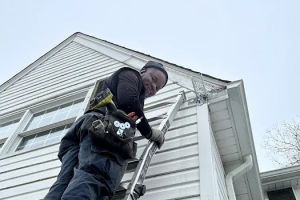
- Understanding-How-Termites-Enter
- Identifying-Foundation-Vulnerabilities
- Preventative-Techniques-and-Barriers
- Chemical-and-Natural-Treatment-Options
- Real-World-Cases-and-Prevention-Success-Stories
- Expert-Tips-for-Long-Term-Foundation-Protection
- Professional-Help-and-Recommended-Resources
1. Understanding How Termites Enter
Termites are silent invaders, capable of causing extensive structural damage long before homeowners even notice them. One of their most common entry points is through the foundation — the very structure that supports your home. Understanding how termites gain access is the first step to preventing infestations.
Subterranean termites, which are the most destructive species in the United States, live underground and travel through mud tubes to reach food sources. They often find entry points through foundation cracks, plumbing gaps, or areas where soil meets wood. Because their activity is hidden, homeowners frequently underestimate the risk until significant damage has already occurred.
2. Identifying Foundation Vulnerabilities
2.1. Cracks and Gaps in Concrete
Even small foundation cracks — as narrow as 1/32 of an inch — can serve as doorways for termites. They are drawn to these weak points, especially in humid or waterlogged soil conditions. Regular inspection and prompt sealing of these cracks are essential to keeping your foundation secure.
2.2. Improper Soil-to-Wood Contact
When wooden structures, such as porch supports or siding, are in direct contact with soil, termites can bypass visible areas and move undetected into your home. Experts recommend maintaining at least an 18-inch clearance between the soil and any exposed wood. Using concrete or metal supports under wooden beams is another effective preventive measure.
2.3. Poor Drainage and Excess Moisture
Moisture is one of the biggest termite attractants. Standing water near your foundation, leaky gutters, or faulty downspouts can soften the soil, making it easier for termites to tunnel through. Effective grading and drainage maintenance help redirect water away from the foundation, reducing the likelihood of infestation.
3. Preventative Techniques and Barriers
3.1. Physical Barriers
Installing physical termite barriers during or after construction can significantly reduce infestation risks. Stainless steel mesh and sand barriers are popular in the U.S. for creating impassable zones around foundations. These materials are long-lasting and environmentally friendly, offering an effective defense without chemicals.
3.2. Moisture Barriers
Vapor or moisture barriers — usually made of thick polyethylene sheets — protect crawlspaces and foundations from excess humidity. Keeping your crawlspace dry prevents both termites and mold from thriving. Homeowners who combine moisture control with soil treatment achieve the highest level of protection.
3.3. Regular Foundation Inspections
Annual inspections by certified pest professionals can detect early signs of termite activity, such as mud tubes or damaged wood. Homeowners should also perform visual checks every few months, especially around plumbing lines, expansion joints, and utility penetrations.
4. Chemical and Natural Treatment Options
4.1. Soil Treatments and Termiticides
Chemical barriers are among the most effective ways to protect a foundation. Licensed pest control experts apply liquid termiticides around and beneath the foundation to create a treated zone that kills or repels termites. Popular active ingredients include fipronil and imidacloprid, both known for long-lasting protection.
4.2. Bait Systems
Bait systems use slow-acting termiticides inside underground stations placed around the home. Termites feed on the bait and share it with the colony, gradually eliminating the infestation. This method is safer for pets and children and provides ongoing monitoring against future invasions.
4.3. Eco-Friendly Alternatives
For homeowners seeking natural approaches, options like diatomaceous earth, orange oil, and nematodes can offer mild protection. While these methods are not as long-lasting as professional treatments, they can supplement barrier systems effectively when applied regularly.
5. Real-World Cases and Prevention Success Stories
In Florida, a homeowner discovered termite tunnels creeping up their foundation wall only six months after a rainy season began. After consulting pest control experts, they installed a combination of stainless steel mesh barriers and a soil treatment perimeter. Two years later, no termite activity was found, and the foundation remained structurally sound.
Similarly, in Texas, a property manager implemented a proactive termite prevention plan across multiple homes using vapor barriers and annual bait system inspections. Over five years, infestations dropped by more than 80%, demonstrating how consistent preventive strategies yield long-term results.
6. Expert Tips for Long-Term Foundation Protection
6.1. Maintain a Dry Perimeter
Ensure proper water drainage by extending downspouts at least six feet from your home and grading soil away from the foundation. Termites thrive in damp conditions, so eliminating moisture sources drastically reduces their access.
6.2. Store Wood Away from Foundation Walls
Stacking firewood, mulch, or lumber near the foundation invites termites to explore. Always store wooden materials at least 20 feet from your home and keep them elevated off the ground. This simple precaution prevents accidental attraction.
6.3. Seal and Treat Foundation Gaps
Regularly seal utility openings, expansion joints, and foundation cracks with waterproof caulk or foam. If your home is older, consider hiring a pest control specialist to apply protective coatings or termiticide-infused sealants for added security.
7. Professional Help and Recommended Resources
While DIY solutions can reduce termite risks, professional inspection and treatment remain the most reliable defense. Licensed pest control companies use specialized tools and data-driven monitoring systems that most homeowners lack access to.
For those in the U.S. seeking trusted termite prevention products and expert services, PestControlHub provides a comprehensive directory of certified providers and guides on foundation protection. Their team also reviews top-rated termite barriers and treatment solutions to help homeowners make informed decisions that fit their budget and local conditions.









 Wildlife Resolutions4.0 (443 reviews)
Wildlife Resolutions4.0 (443 reviews) Pest Marshals of Toledo5.0 (2 reviews)
Pest Marshals of Toledo5.0 (2 reviews) LS Rodent Proofing & Pest Control Service5.0 (4 reviews)
LS Rodent Proofing & Pest Control Service5.0 (4 reviews) Best Termite & Pest Control4.0 (16 reviews)
Best Termite & Pest Control4.0 (16 reviews) Varment Guard Wildlife Services5.0 (28 reviews)
Varment Guard Wildlife Services5.0 (28 reviews) Pestban Inc4.0 (394 reviews)
Pestban Inc4.0 (394 reviews) How to Use Monitors to Detect Pest Entry: A Comprehensive Guide
How to Use Monitors to Detect Pest Entry: A Comprehensive Guide How to Predict Which Pests Will Invade Next – Smart Pest Forecasting for the U.S.
How to Predict Which Pests Will Invade Next – Smart Pest Forecasting for the U.S. How to Conduct a Pest Risk Assessment at Home – Expert Guide
How to Conduct a Pest Risk Assessment at Home – Expert Guide How to Block Pest Entry Around Deck Joists: Effective Solutions
How to Block Pest Entry Around Deck Joists: Effective Solutions How to Safely Use Fumigation Methods: A Comprehensive Guide for Homeowners
How to Safely Use Fumigation Methods: A Comprehensive Guide for Homeowners Why Pests Are More Active After Rain: Understanding the Link Between Weather and Pest Behavior
Why Pests Are More Active After Rain: Understanding the Link Between Weather and Pest Behavior